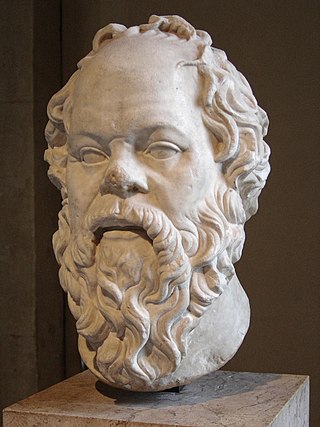In propositional logic, affirming the consequent, sometimes called converse error, fallacy of the converse, or confusion of necessity and sufficiency, is a formal fallacy of taking a true conditional statement under certain assumptions, and invalidly inferring its converse, even though that statement may not be true under the same assumptions. This arises when the consequent has other possible antecedents.
In propositional logic, modus ponens, also known as modus ponendo ponens, implication elimination, or affirming the antecedent, is a deductive argument form and rule of inference. It can be summarized as "P implies Q.P is true. Therefore, Q must also be true."
In propositional logic, modus tollens (MT), also known as modus tollendo tollens and denying the consequent, is a deductive argument form and a rule of inference. Modus tollens is a mixed hypothetical syllogism that takes the form of "If P, then Q. Not Q. Therefore, not P." It is an application of the general truth that if a statement is true, then so is its contrapositive. The form shows that inference from P implies Q to the negation of Q implies the negation of P is a valid argument.

A syllogism is a kind of logical argument that applies deductive reasoning to arrive at a conclusion based on two propositions that are asserted or assumed to be true.
Deductive reasoning is the mental process of drawing deductive inferences. An inference is deductively valid if its conclusion follows logically from its premises, i.e. it is impossible for the premises to be true and the conclusion to be false.
Denying the antecedent, sometimes also called inverse error or fallacy of the inverse, is a formal fallacy of inferring the inverse from an original statement. It is a type of mixed hypothetical syllogism in the form:
In logic and mathematics, the converse of a categorical or implicational statement is the result of reversing its two constituent statements. For the implication P → Q, the converse is Q → P. For the categorical proposition All S are P, the converse is All P are S. Either way, the truth of the converse is generally independent from that of the original statement.
In classical logic, a hypothetical syllogism is a valid argument form, a deductive syllogism with a conditional statement for one or both of its premises. Ancient references point to the works of Theophrastus and Eudemus for the first investigation of this kind of syllogisms.

In term logic, the square of opposition is a diagram representing the relations between the four basic categorical propositions. The origin of the square can be traced back to Aristotle's tractate On Interpretation and its distinction between two oppositions: contradiction and contrariety. However, Aristotle did not draw any diagram; this was done several centuries later by Apuleius and Boethius.
In logic and formal semantics, term logic, also known as traditional logic, syllogistic logic or Aristotelian logic, is a loose name for an approach to formal logic that began with Aristotle and was developed further in ancient history mostly by his followers, the Peripatetics. It was revived after the third century CE by Porphyry's Isagoge.
The fallacy of the undistributed middle is a formal fallacy that is committed when the middle term in a categorical syllogism is not distributed in either the minor premise or the major premise. It is thus a syllogistic fallacy.
In classical logic, intuitionistic logic and similar logical systems, the principle of explosion, or the principle of Pseudo-Scotus, is the law according to which any statement can be proven from a contradiction. That is, from a contradiction, any proposition can be inferred; this is known as deductive explosion.
The fallacy of four terms is the formal fallacy that occurs when a syllogism has four terms rather than the requisite three, rendering it invalid.
A fallacy of illicit transference is an informal fallacy occurring when an argument assumes there is no difference between a term in the distributive and collective sense.
The fallacy of exclusive premises is a syllogistic fallacy committed in a categorical syllogism that is invalid because both of its premises are negative.
In propositional logic, transposition is a valid rule of replacement that permits one to switch the antecedent with the consequent of a conditional statement in a logical proof if they are also both negated. It is the inference from the truth of "A implies B" to the truth of "Not-B implies not-A", and conversely. It is very closely related to the rule of inference modus tollens. It is the rule that
In logic and philosophy, a formal fallacy, deductive fallacy, logical fallacy or non sequitur is a pattern of reasoning rendered invalid by a flaw in its logical structure that can neatly be expressed in a standard logic system, for example propositional logic. It is defined as a deductive argument that is invalid. The argument itself could have true premises, but still have a false conclusion. Thus, a formal fallacy is a fallacy where deduction goes wrong, and is no longer a logical process. This may not affect the truth of the conclusion, since validity and truth are separate in formal logic.
The politician's syllogism, also known as the politician's logic or the politician's fallacy, is a logical fallacy of the form:
- We must do something.
- This is something.
- Therefore, we must do this.

